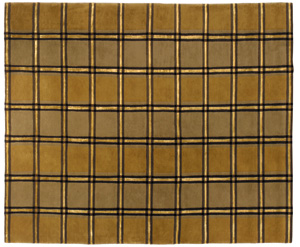Outlook for the Fall Selling Season: Economic Doldrums Inspire New Creativity and Innovation in the Rug Segment

Rug producers are not using the economic slowdown as an excuse to play it safe. In fact, a wave of imaginative new products, many of which reflect a true sea change in styling, will pour onto the market this fall. Color palettes are lighter and clearer, and designs are cleaner and more contemporary. Somber tea-stained looks and intricate patterns suddenly seem dark and fussy.
New rugs that are being introduced at the October textiles and home furnishings markets feature sun-lit shades of beige, wheat, mauve, and sage. In traditional styling, many designs feature larger figures and more open fields. The growing contemporary category is either wild and asymmetrical, or simple and elegantly tailored.
"Styling is changing rapidly," says retailer John Murse of Sarasota, Fla.-based Rugs as Art. "The dark tea-washed rugs are looking very old. I saw a lot of extremely interesting things at summer market and I'm glad I was there to get the first shot at them this fall. People who missed the market are going to be behind the curve."
Rug executives say styling turnover is faster than ever. "A new collection is introduced, has a growth spurt and boom, it's over in six months or a year," notes Diane Carleo, director of marketing for United Weavers. "The cycle keeps getting shorter and we have to work faster than ever to bring out new products."

"We introduced a lot of new product in July, and that has helped keep our business ahead," he continues. "We are also committed to many new lines in October and again in January. In January, I think we'll see a whole new design statement in terms of greater pattern variety and new colors."
Optimism reigns despite economic uncertainty
The rug industry has not been left unscathed by the recent economic downturn. Despite five years of double-digit growth, most industry observers predict growth of only about 3% this year.
Yet, optimism always buoys this business.
"We are very fortunate to be in an industry that offers so much product diversification and so many channels of distribution," says Bill Kilbride, president of Mohawk Home. "It makes me glad I'm not selling car batteries. We are as far removed from the commodity mentality as possible.

Kilbride says Mohawk Home is combating the economic slowdown by expanding its business base on two fronts: the export market and new retail channels. "We have tremendous untapped opportunities with our nearest neighbors, Canada and Mexico," he explains. "We are also increasing penetration in furniture and home accents stores through the new Thomas Kinkade collection, distributed through the Goodwin Weavers division."
Mohamid Farid, president of Cairo, Egypt-based Oriental Weavers, thinks being optimistic makes good business sense. "Executives react to an economic slowdown in one of two ways: they either panic and lose their appetite for business, or they develop new products and marketing methods," he explains. "The more innovation and creativity we bring to our customers, the more appetite they will have for new business, as well."
A slow economy can fuel creative fires, Momeni Executive Vice President Reza Momeni agrees. "When business is soft, vendors get a lot more innovative. That's good for the entire industry, and especially for the consumer," he says.

Retailer Steve Lazewski of California Carpet in San Francisco comments that when times get tough, retailers should push even harder. "You can't stop promoting just because the economy is in a recession," he says. "We keep advertising, and we treat our customers right. So we honestly can't complain about business."
Product diversity is key
Alex Peykar, a principal at Nourison, feels that new products are even more important when times are tough. "Product differentiation and diversity is always key, but it is particularly important in an economic downturn. The moderate-priced business has not disappeared, but that customer may be more cautious. That's a challenge to make us more creative. Product drives this business," he says.

"People are responding to our efforts to become a one-stop resource," notes 828 Chairman John Shepherd. "We now have a very extensive line of both handmade and machine-made rugs with emphasis on both style and value. We hope to add carpeting to the equation this fall."
L. de Poortere is also moving toward a totally coordinated package of rugs, runners and broadloom. "The philosophy is 'Keep it Simple, Stupid,'" said company president Terry Flamant. "It's a streamlined program with a limited number of designs."
New licensing programs
New licensing programs that tie in with large home-furnishings umbrella programs are also helping to add excitement to product launches this fall.
Nourison's Peykar says his company's first Calvin Klein rugs will be introduced in New York with a full-scale fashion opening.

"In spite of the economy and the slow market traffic, the new Tommy Bahama line was our most successful licensing introduction ever," he says. "People came to market specifically to see it, and it also generated sales for our other collections."
"Bob Mackie is going through a huge resurgence, and that glamour and recognition is rubbing off on our rugs," says Paul D'huyvetter, executive vice president and general manager of Oriental Weavers USA. "As the program continues to develop, Mackie is becoming more personally involved with the design and colorations, as well. It makes a big difference."
Oriental Weavers is also deeply involved with plans for introducing its recently announced Raymond Waites licensing program, and the first products should be ready this Fall, according to D'huyvetter.
Couristan will celebrate its 75th anniversary later this year. "We have some very aggressive plans, in terms of both promotions and products," promised Couristan President Ron Couri. "We are experimenting with new looks in the middle price points in hand-tufted and hooked constructions."
Looking for a reprint of this article?
From high-res PDFs to custom plaques, order your copy today!


